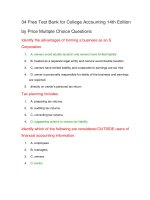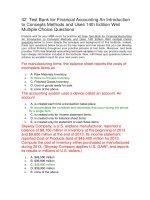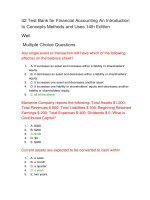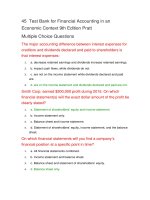90 test bank for management accounting 6th
Bạn đang xem bản rút gọn của tài liệu. Xem và tải ngay bản đầy đủ của tài liệu tại đây (98.5 KB, 25 trang )
90 Test Bank for Management Accounting 6th
True-False Questions
Planning refers to setting objectives, implementing plans, and evaluating
objectives.
1.
True
2.
False
Line departments support or service staff departments.
1.
True
2.
False
Management by exception involves a detailed analysis of all deviations from
planned performance regardless of the amount.
1.
True
2.
False
The essence of the just-in-time philosophy is to eliminate waste.
1.
True
2.
False
Both internal managers and external parties use accounting information.
1.
True
2.
False
Organizations that do not make or sell tangible goods are called service
organizations.
1.
True
2.
False
The cost-benefit balance is the primary consideration in choosing among
accounting systems and methods.
1.
True
2.
False
The factors causing changes in management accounting today include
increased global competition, technological advances and increased
production by Canadian companies.
1.
True
2.
False
The Society of Management Accountants of Canada (SMAC. has developed
standards of ethical conduct for management accountants, which include
standards of competence, confidentiality, integrity and objectivity.
1.
True
2.
False
A budget is a quantitative expression of a plan of action.
1.
True
2.
False
The CMA program focuses on management accounting and its role in
Canadian business.
1.
True
2.
False
According to the Financial Executives Institute, the controller's function is to
obtain both short-term and long-term loans.
1.
True
2.
False
Sales growth occurs in the mature market stage of product life cycle.
1.
True
2.
False
Internal accounting reports must follow generally accepted accounting
principles and account for assets at historical cost.
1.
True
2.
False
Line authority is authority exerted downward over subordinates.
1.
True
2.
False
Multiple Choice Questions-Page 1
________ concentrate(s. on areas that deviate from the plan and ignore(s.
areas that are presumed to be running smoothly.
1.
A. A budget
2.
B. Performance reports
3.
C. Variances
4.
D. Management by exception
________ is (are. deviations from plans.
1.
A. A budget
2.
B. Performance reports
3.
C. Variances
4.
D. Management by exception
A survey of managers selected which of the following business areas as the
most common starting-point for future managers?
1.
A. Accounting.
2.
B. Finance.
3.
C. Legal environment of business.
4.
D. Computers in business.
A quantitative expression of a plan of action is a
1.
A. variance.
2.
B. performance report.
3.
C. control.
4.
D. budget.
Financial accounting is constrained by GAAP. Management accounting is
constrained by
1.
A. GAAS.
2.
B. the cost-benefit balance.
3.
C. Revenue Canada.
4.
D. the controller.
Cooking dinner and tasting the food are examples of
1.
A. planning.
2.
B. controlling.
3.
C. budgeting.
4.
D. analyzing.
Service organizations
1.
A. sell tangible goods.
2.
B. are not wholesalers.
3.
C. are considered manufacturers.
4.
D. must be profit-seeking.
________ is a formal mechanism for gathering, organizing, and
communicating information about an organization's activities.
1.
A. An accounting system
2.
B. Scorekeeping
3.
C. Management accounting
4.
D. Attention directing
________ is the aspect of accounting that quantifies the likely results of
possible courses of action and often recommends the best course to follow.
1.
A. Scorekeeping
2.
B. Attention directing
3.
C. Problem-solving
4.
D. None of the above
________ is the accumulation and classification of data.
1.
A. An accounting system
2.
B. Scorekeeping
3.
C. Management accounting
4.
D. Attention directing
The watchword for the installation of systems in service industries and
nonprofit organizations is
1.
A. maximize.
2.
B. simplicity.
3.
C. constraints.
4.
D. complexity.
________ refers to accounting information developed for users within an
organization.
1.
A. An accounting system
2.
B. Scorekeeping
3.
C. Management accounting
4.
D. Financial accounting
________ is (are. a quantitative expression(s. of a plan of action.
1.
A. A budget
2.
B. Performance reports
3.
C. Variances
4.
D. Management by exception
Planning determines action, action generates feedback, and feedback
influences
1.
A. reports.
2.
B. accounting systems.
3.
C. further planning.
4.
D. deviations.
An accounting system should provide accurate, timely budgets and
performance reports in a form useful to
1.
A. shareholders.
2.
B. bankers.
3.
C. Revenue Canada.
4.
D. managers.
A clerk prepares a monthly report comparing the actual phone bill with the
expected phone costs. This activity would be classified as
1.
A. problem-solving.
2.
B. scorekeeping.
3.
C. planning.
4.
D. attention directing.
Management accounting refers to accounting information developed for
1.
A. shareholders.
2.
B. governmental authorities.
3.
C. managers within an organization.
4.
D. loan officers.
________ provide(s. feedback by comparing results with plans and by
highlighting deviations from plans.
1.
A. A budget
2.
B. Performance reports
3.
C. Variances
4.
D. Management by exception
Which of the following is a characteristic of both profit-seeking and nonprofit
service organizations?
1.
A. Labour is intensive.
2.
B. Output is usually difficult to define.
3.
C. Major inputs and outputs cannot be stored.
4.
D. All of the above are characteristics.
________ means reporting and interpreting information that helps managers
to focus on operating problems, imperfections, inefficiencies, and
opportunities.
1.
A. Scorekeeping
2.
B. Attention directing
3.
C. Problem-solving
4.
D. None of the above
The codes of conduct for integrity include all of the following EXCEPT
1.
A. avoiding actual or apparent conflicts of interest.
2.
B. refusing to advise or assist with the commission of fraud.
3.
C. recognizing and communicating professional limitations.
4.
D. communicating information subjectively.
Answering the following questions: When is dinner? Who is cooking it? is an
example of
1.
A. planning.
2.
B. controlling.
3.
C. budgeting.
4.
D. analyzing.
Broad guidelines and detailed practices that together make up accepted
accounting practice at a given time are referred to as
1.
A. GAAS.
2.
B. accounting conventions.
3.
C. GAAP.
4.
D. Revenue Canada regulations.
The primary consideration in choosing among accounting systems and
methods is
1.
A. simplicity.
2.
B. behavioural issues.
3.
C. cost-benefit balance.
4.
D. computerization.
A characteristic of service organizations is that
1.
A. labour is intensive.
2.
B. output is easy to define.
3.
C. major inputs and outputs can be stored.
4.
D. plant and equipment costs are high in proportion to labour costs.
Launching a new product line is an example of
1.
A. decision making.
2.
B. planning.
3.
C. controlling.
4.
D. organization.
57 Free Test Bank for Management Accounting 6th
Canadian Edition by Horngren Multiple Choice
Questions-Page 2
Chartered Accountants are
1.
A. internal auditors.
2.
B. management accountants.
3.
C. external auditors.
4.
D. clerical accountants.
A philosophy to eliminate waste by reducing the time products spend in the
production process and eliminating the time that products spend on activities
that do NOT add value is
1.
A. computer-integrated manufacturing.
2.
B. just-in-time.
3.
C. better late than never.
4.
D. added value tax.
Actual results are compared to budgeted amounts in a
1.
A. performance report.
2.
B. financial statement.
3.
C. production report.
4.
D. flexible report.
Product life cycles
1.
A. are the same for all products.
2.
B. must be considered to effectively plan for production.
3.
C. are computerized bicycles.
4.
D. have nothing to do with product profitability.
According to the Financial Executives Institute, one function of controllership
is
1.
A. investments.
2.
B. short-term financing.
3.
C. provision of capital.
4.
D. reporting and interpreting.
The product development stage in a product's life cycle corresponds to
1.
A. no sales.
2.
B. sales growth.
3.
C. stable sales level.
4.
D. low and decreasing sales.
Authority exerted downward over subordinates is referred to as
1.
A. line authority.
2.
B. staff authority.
3.
C. general authority.
4.
D. specific authority.
The introduction to market stage in a product's life cycle corresponds to
1.
A. no sales.
2.
B. sales growth.
3.
C. stable sales level.
4.
D. low and decreasing sales.
The various stages through which a product passes are called the
1.
A. product life cycle.
2.
B. production plan.
3.
C. market analysis.
4.
D. product initiative.
The Society of Management Accountants has adopted a set of standards of
professional ethics which includes codes of conduct regarding all of the
following EXCEPT
1.
A. competence.
2.
B. independence.
3.
C. integrity.
4.
D. confidentiality.
Authority to advise but NOT command is called
1.
A. line authority.
2.
B. staff authority.
3.
C. general authority.
4.
D. specific authority.
Which of the following statements about line authority is TRUE? Line
authority
1.
A. is similar to staff authority.
2.
B. is indirectly related to the basic activities of an organization.
3.
C. is exerted upwardly from subordinates.
4.
D. includes the authority to command action.
Which of the following statements about management accounting is FALSE?
1.
A. It is concerned with how measurements and reports will influence managers' daily
behaviour.
2.
B. It is less sharply defined than financial accounting.
3.
C. Its primary users are organizational managers at various levels.
4.
D. It is constrained by generally accepted accounting principles.
A synonym for deviation is
1.
A. planned.
2.
B. systematic.
3.
C. variance.
4.
D. reported.
The mature market stage in a product's life cycle corresponds to
1.
A. no sales.
2.
B. sales growth.
3.
C. stable sales level.
4.
D. low and decreasing sales.
A significant unfavourable variance
1.
A. should be ignored because of materiality.
2.
B. could not result from careless budgeting.
3.
C. is the result of proper planning.
4.
D. should be analyzed, and measures should be taken to correct the situation.
Management accountants are similar to CAs and CGAs in that they
1.
A. give opinions on financial statements.
2.
B. are licensed by the Canadian Institute of public accountancy.
3.
C. adhere to codes of conduct.
4.
D. are independent of the company they work for.
Systems that use CAD and CAM together with robots and computer-controlled
machines are called
1.
A. JIT.
2.
B. CMA.
3.
C. CIM.
4.
D. none of the above.
Systems that use computer-aided design and computer-aided manufacturing,
together with robots and computer-controlled machines are called
1.
A. just-in-time systems.
2.
B. robotic-computer systems.
3.
C. computer-integrated manufacturing systems.
4.
D. manufacturing-robotic systems.
According to the Financial Executives Institute, one function of treasurership
is
1.
A. planning for control.
2.
B. protection of assets.
3.
C. investor relations.
4.
D. economic appraisal.
The top accounting officer in an organization is often
1.
A. the controller.
2.
B. the treasurer.
3.
C. the CFO.
4.
D. the CEO.
Which of the following factors is causing changes in management accounting
today?
1.
A. Shift from a manufacturing-based to a service-based economy.
2.
B. Increased global competition.
3.
C. Advances in technology.
4.
D. All of the above are factors.
________ is the designation that provides the greatest orientation toward
management accounting.
1.
A. CIA
2.
B. CMA
3.
C. CEO
4.
D. CGA
An example of a line department at a jewelry manufacturer is the
1.
A. accounting department.
2.
B. finance department.
3.
C. maintenance department.
4.
D. sales department.
The largest Canadian association of professional accountants whose major
interest is management accounting is the
1.
A. Canadian Institute of Chartered Accountants.
2.
B. Certified General Accountants of Canada.
3.
C. Government Accounting Institute.
4.
D. Society of Management Accountants of Canada.
Which of the following statements about ethical dilemmas faced by
management accountants is FALSE? Ethical dilemmas
1.
A. are clear-cut.
2.
B. involve conflict between two or more ethical standard.
3.
C. require individual integrity and judgment.
4.
D. require the application of ethical standards.
Below is a statement from the Code of Professional Ethics for the Society of
Management Accountants. "Maintain at all times independence of thought and
action." It is an example of
1.
A. competence.
2.
B. confidentiality.
3.
C. integrity.
4.
D. objectivity.
Which of the following individuals would likely NOT be users of management
accounting reports?
1.
A. company presidents
2.
B. university deans
3.
C. bankers
4.
D. chief physicians
The phase-out-of-product stage in a product's life cycle corresponds to
1.
A. no sales.
2.
B. sales growth.
3.
C. stable sales level.
4.
D. low sales to no sales.
________ is mainly concerned with the company's financial matters.
1.
A. The controller
2.
B. The treasurer
3.
C. The secretary
4.
D. None of the above
Management by exception means management concentrates on
1.
A. significant activities proceeding as planned.
2.
B. significant deviations from expected results.
3.
C. insignificant activities proceeding as planned.
4.
D. insignificant deviations from expected results.
Free Text Questions
Deviations from plans.
Answer Given
Variances
Authority exerted downward over subordinates.
Answer Given
Line authority
Explain the cost-benefit and behavioral issues involved in designing an
accounting system.
Answer Given
The cost-benefit balance, weighing known costs against probable benefits, is the
primary consideration in choosing among accounting systems. The system's value
must exceed its cost. In addition, the system's effects on the behaviour of managers
should also be considered. The system must provide accurate, timely budgets and
performance reports in a form useful to managers.
Describe the major users of accounting information.
Answer Given
In general, users of accounting information fall into three categories: (1. Internal
managers who use the information for short-term planning and controlling routine
operations. (2. Internal managers who use the information for making nonroutine
decisions and formulating overall policies and long-range plans. (3. External parties,
such as investors and government authorities, who use the information for making
decisions about the company.
The largest Canadian professional organization of accountants whose major
interest is management accounting.
Answer Given
Society of Management Accountants
Contrast the functions of controllers and treasurers.
Answer Given
The treasurer is concerned mainly with the company's financial matters such as
investor relations, provision of capital, short-term financing, credits and collections,
and banking. The controller is concerned with operating matters such as reporting and
interpreting, evaluating and consulting, tax administration, government reporting, and
protection of assets.
Concentrating on areas that deserve attention and ignoring areas that are
presumed to be running smoothly.
Answer Given
Management by exception
Distinguish between line and staff roles in an organization, and give an
example of each.
Answer Given
Line authority is authority exerted downward over subordinates. Staff authority is
authority to advise but not to command. It may be exerted downward, laterally, or
upward. Line departments are directly responsible for conducting the basic mission of
the organization, that is, producing and selling a product or service. Staff departments
are indirectly related to these basic activities through servicing and supporting the line
departments. An example of a line role would be the sales executives, whereas a staff
role would include the top accounting executive.
Discuss the role that management accountants play in the company's valuechain functions.
Answer Given
Management accountants play a key role in planning and control. Throughout the
company's value chain, management accountants gather and report cost and revenue
information for decision makers.
Weighing known costs against probable benefits, the primary consideration in
choosing among accounting systems and methods.
Answer Given
Cost-benefit balance
A quantitative expression of a plan of action, and an aid to coordinating and
implementing the plan.
Answer Given
Budget
Explain a management accountant's ethical responsibilities.
Answer Given
A certified management accountant must adhere to a code of conduct regarding
competence, confidentiality, integrity, and objectivity developed by the Society of
Management Accountants. An unethical act is one that violates the ethical standards
of the profession. Management accountants have an obligation to the organizations
they serve, their profession, the public, and themselves to maintain the highest
standards of ethical conduct.
Identify current trends in management accounting.
Answer Given
Many factors have caused changes in accounting systems in recent years. Most
significant are globalization, technology, and a shift from a manufacturing-based to a
service-based economy. Without continuous adaptation and improvement, accounting
systems would be obsolete.
Explain the role of budgets and performance reports in planning and control.
Answer Given
Budgets and performance reports are essential tools for planning and control. Budgets
result from the planning process. Managers use them to translate the organization's
goals into action. A performance report compares actual results to the budget.
Managers use these reports to monitor, evaluate, and reward performance and, thus,
exercise control.
A philosophy to eliminate waste, by reducing the time products spend in the
production process and eliminating the time that products spend on activities
that do not add value.
Answer Given
Just-in-time philosophy
Broad concepts or guidelines and detailed practices, including all
conventions, rules, and procedures that together make up accepted
accounting practice at a given time.
Answer Given
Generally accepted accounting principles
The person from whom the controller derives authority to set accounting
procedures.
Answer Given
The company president
Authority to advise but not to command. It may be exerted downward,
laterally, or upward.
Answer Given
Staff authority







